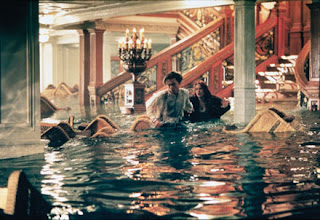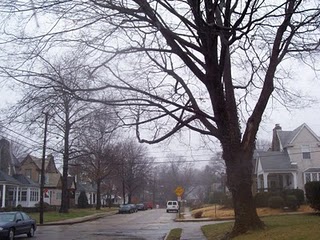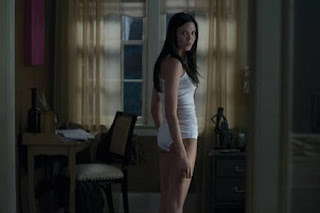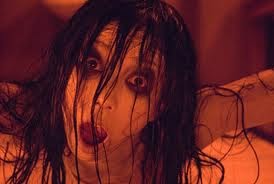24th September 2010 Miss Lecionte
Learning objective: Show understanding of the term cinematography and how it is used within thriller films.
Lesson outcome:
All: Be able to identify and describe at least one camera element. (E)
Most: Be able to identify and explain 3 or more camera elements with examples. (C)
Some: Be able to use media language correctly to analyse the effects the camera shots have with appropriate examples. (A)
The three main elements that make up cinematography are:
- Camera movements
- Camera angles
- Camera positions
Camera positions
 This is an example of a Long shot (LS). This shot shows a fairly large subject (such as a person) and usually much of the surrounding. In this example you can see the characters. Also the flood is taking up half of the shot. This would help the audience to see what the character is doing as well as the location and situation their in. So this shot would help me in my thriller film because it can bring suspense to the audience by the characters actions or what position they are in.
This is an example of a Long shot (LS). This shot shows a fairly large subject (such as a person) and usually much of the surrounding. In this example you can see the characters. Also the flood is taking up half of the shot. This would help the audience to see what the character is doing as well as the location and situation their in. So this shot would help me in my thriller film because it can bring suspense to the audience by the characters actions or what position they are in. Here is another example of a Long shot (LS) which I took in school. This exercise helped me because now i have a rough idea about how to measure the right shot and how far or close i should be to the character for when im using a camera to film.
 This is an example of an Extreme long shot (ELS). This shot is sometimes used as an establishing shot. This is because the camera is at its furthest distance from the subject, emphasising the background and also reducing the importance of the subject. In this example there is no subject but it shows us a location. This shot can help me with making a thriller film because it can show the location of my scenes. I would prefer to use this shot than I establishing shot if there was a character in the scene because although you won’t focus on the character, you will still be able to see it. This shot can be used in any part of the film, but with an establishing shot, it would usually be only at the beginning of the film.
This is an example of an Extreme long shot (ELS). This shot is sometimes used as an establishing shot. This is because the camera is at its furthest distance from the subject, emphasising the background and also reducing the importance of the subject. In this example there is no subject but it shows us a location. This shot can help me with making a thriller film because it can show the location of my scenes. I would prefer to use this shot than I establishing shot if there was a character in the scene because although you won’t focus on the character, you will still be able to see it. This shot can be used in any part of the film, but with an establishing shot, it would usually be only at the beginning of the film.This is an example of an Establishing shot (ES). This shot defines the location and gives the audience a perspective on the action that is to follow. This shot is similar to an extreme long shot and is used to define a genre. From this example I would determine that this would have been taking from a thriller film; this is because of the dark atmosphere. This shot will help me with my thriller film because it will make the audience determine what genre my film is. This is why I need to make my establishing shot look like it’s a thriller film. I can do this by using low key lighting like in the example.
This is an example of a Master shot (MS). This shot is similar to the establishing shot as they are both used at the beginning of a film. Although this shot is used at the beginning of the sequence as a reference point for the rest of the film. This is an example of New York City. This shows us that the location of the film will continue to be in New York City. This shot will help me in my thriller film because as it determines the location throughout the film; the buildings/atmosphere may show us the genre of the film.
 This is an example of a Medium long shot (MLS). This is when the shot focus on the subject from the knees upwards. It also permits a balance between the subject and surrounding. This is an example from the film 'Unborn'. Because the shot is from her knees, it makes a balance between her and the background she is in. This shot will help me in my thriller film because if i wanted to show the character but no focus their facial reaction but their actions around the location their at then this would be the perfect shot.
This is an example of a Medium long shot (MLS). This is when the shot focus on the subject from the knees upwards. It also permits a balance between the subject and surrounding. This is an example from the film 'Unborn'. Because the shot is from her knees, it makes a balance between her and the background she is in. This shot will help me in my thriller film because if i wanted to show the character but no focus their facial reaction but their actions around the location their at then this would be the perfect shot.This is an example of a Medium shot (MS). This is when the camera frames the actor from the waist up. This is from the film 'Friday the 13th'. This shot makes us focus more on the character than the background. This shot will help me in my thriller film because the audience focuses on the character more. So this shot would be suitable for a scene where we focus on the characters and their actions.
Here is another example of a Medium shot (MS) which I took in school. This was part of a excercise I did in class to help us to know about shots. This exercise helped me because now i have a rough idea about how to measure the right shot and how far or close i should be to the character for when im filming.
 This is an example of a Close up (CU). This shows a fairly small part of the scene and emphasises on something, such as a characters face expression and neck in detail that it fills the screen. This is a scene from 'Grudge'. As you can see when you first look at the example you look at the characters face expression. This shot will help me in my thriller film because showing the characters face expression will either bring sympathy, suspense etc.
This is an example of a Close up (CU). This shows a fairly small part of the scene and emphasises on something, such as a characters face expression and neck in detail that it fills the screen. This is a scene from 'Grudge'. As you can see when you first look at the example you look at the characters face expression. This shot will help me in my thriller film because showing the characters face expression will either bring sympathy, suspense etc.This is an example of an Extreme close up (ECU). This shot singles out a portion of the face isolates detail and magnifies the minute. This example shows a scene from 'Grudge'. As you can see we focus on the eye on her face. This shot will help me in my thriller film because if I wanted to make the audience to focus on a certain feature on a character then I would use this shot. Also it allows the audience to get up and personal with the character.
This is an example of a Point of view (POV). This shot implies that the camera is looking from the eyes of the subject. This shot can help in my thriller film because it will add suspense. It also gives the audience the chance to see what’s going on form the characters eyes.
This is an example is a Two shot (TS). This shot is where two people are featured in the frame. This example is from 'Final destination'. This shot can help me when I’m making my thriller film because I can use this shot to show the audience the actions of two characters at the same time.
This is an example of an Over the Shoulder shot. This is where the camera is placed at shoulder level and is shot this way. This is an example from 'Grudge' and shows us that the character cannot see that there’s someone behind her. This shot will help me in my thriller film because it will bring suspense to the audience especially if there’s someone behind a character and they can't see.
.
This is an example of an Over Head shot. This shows the subject and surrounding to get more of an impact on what’s happening. From the example this shot could also be used as a point of view shot because the two people could be looking up at someone. This shot can help me in my thriller film because it can show where a character may be heading and this may bring suspense to the audience because the character may be running away from something
Camera angles
Straight on angle is the most common angle used, an angel that is at eye line level facing straight on.
Camera movements
Zoom is when the camera doesn’t move and the lens is focused down from the long shot to the close up, whilst recoding. This can by used when to show an emphasise on a characters face. An example is from one Flew Over The Cuckoo's Nest. Here is the URL for the clip: http://www.youtube.com/watch?v=DCUmINGae44 From 53 seconds till the end the camera is zooming. This would create more sympathy to the audince because the zoom was very slow and we we're focussing on the characters face expression.
Altough if the zooming was fast then it would make the audience focus on a certain part of the scene quicker. This type of zoom was is underneath and is from Friday the 13th. From 1.22 seconds to 1.28 seconds there is a zoom. This would make the audience feel part of the film as they are drawn in. This type of camera movement would help me in my thriller film because I can zoom in on a certain item or face expression to make the audience focus there more.
Tracking (dollying) is when the camera itself is moved smoothly towards away from the subject while the focus remains constant. Tracking in (like zooming) draws the audience into a closer relationship with the subject, moving away tends to create emotional distance. Underneath is an example of tracking. From 11 seconds to 29 seconds shows tracking.
Tracking back tends to divert attention to the edges of the screen and the speed of tracking may affect the viewer’s mood.
Altough if the zooming was fast then it would make the audience focus on a certain part of the scene quicker. This type of zoom was is underneath and is from Friday the 13th. From 1.22 seconds to 1.28 seconds there is a zoom. This would make the audience feel part of the film as they are drawn in. This type of camera movement would help me in my thriller film because I can zoom in on a certain item or face expression to make the audience focus there more.
Tracking (dollying) is when the camera itself is moved smoothly towards away from the subject while the focus remains constant. Tracking in (like zooming) draws the audience into a closer relationship with the subject, moving away tends to create emotional distance. Underneath is an example of tracking. From 11 seconds to 29 seconds shows tracking.
Tracking back tends to divert attention to the edges of the screen and the speed of tracking may affect the viewer’s mood.
Pan is when the camera moves from left to right or right to left to follow a moving subject. Underneath is an example of tracking in the film One lew Over The Cuckoo's Nest. From 36 seconds to 42 seconds panning is used. Because the camera is following the character, this can be considered tracking pan. This camera movement can help me in the making of my thriller film because it will allow me to show the audience a large part of the a scene from standing from one place.
Whip pan is when a very fast pan causes the subject to blur.
Whip pan is when a very fast pan causes the subject to blur.
Handheld camera is used to produce a jerky, bouncy, unsteady image, which can create a sense of immediacy or chaos. This would be a good movement i my thriller film as it can cause suspese to the audiece and make them feel like they are looking at the scene from the characters point of view; so they feel part of the film. In my film i would use this type of movement as it is an easy technique to produce a sense of chaos.
Steadicam is a handheld camera worn as a kind of harness. It uses a gyroscope system to ensure the camera remains perfectly level and smooth as the camera moves. As you can see from the picture on the left, there some equipment that is needed. This is expensive and my school does not provid this so i will no be using a steadicam. My alternative to this will be a tripod. This will allow the camera not to be jerky while recording.
Tilt shot is when the camera moves up and down or down and up from a fixed axis.
Tilt shot is when the camera moves up and down or down and up from a fixed axis.
Crane shot is a camera that is mounted on a crane and it moves around at a distance above ground level and it can move up or down. As you can see from this image a crane shot requires equipment that the school doesn't provide and i can't afford. So i would not be using this in my thriller film. The alternative of using a crane shot is to take the shot from a window.
Rolling shot is a camera that moves diagonally, which makes the image askew (often used to show that a character is drugged/drunk.)
Aerial shot is where the camera looks down on something and it is like a bird eye view shot.
I watch the opening of Face Off. Underneath is a table of the work i did in the lesson. This table shows the amount of mid shots and panning i saw in the film:
I watch the opening of Face Off. Underneath is a table of the work i did in the lesson. This table shows the amount of mid shots and panning i saw in the film:
In this lesson i have learnt about cinematography. I believe that cinematography is important in makinig a film because different types of angles and positioning makes different types of effect on the audience. So by doing cinematography, i can make the audience react in a certain way of my choice. This will help me in making the opening scene of my thriller film because i can make appropriate terminology whilst evaluating my work.
















Tolu this is a good effort. You have clearly demonstrated your understanding of cinematography and how you intend to use it within your production. Please be careful of your gramma as you will be marked down for this. Also try and elaborate a little more on the shots you took in class.
ReplyDelete